The short 2017 Virginia General Assembly is now in session. The VAEEC has taken the following positions on energy efficiency-related bills up for consideration:
VAEEC supports HB 1465 (Sullivan)/ SB 990 (Dance)– Requires DMME or GEC to continue tracking progress towards 10% energy reduction goal (SB 990 passed out of committee 1/23 and is headed to the Senate floor; HB 1465 will be in the energy subcommittee of Commerce and Labor on 1/31; SB 990 passed out of the Senate on 1/31 and will go to the House; HB 1465 was passed by indefinitely on 1/31; SB 990 passed out of the House on 2/17).
VAEEC supports HB 1712 (Minchew)– ESCO coalition bill; amends language on cooperative procurements related to energy performance contracts (Passed out of subcommittee unanimously week of 1/16; passed out of the General Laws committee unanimously on 1/24; will go to the full House for a vote during the week of 1/23; passed out of the House on 1/31 and will go to the Senate).
VAEEC opposes HB 1658 (Marshall)– Anti-benchmarking bill; prohibits third party access to data without consumer consent. This bill will not change current law since third parties cannot access consumer data without the consumer’s consent. After convening a workshop on benchmarking that included VAEEC, several of our members and board members and other interested parties — such as property managers, legislators and homebuilders — the Department of Mines, Minerals and Energy (DMME) plans to continue those conversations over the course of the year in the hopes of coming to consensus on what a benchmarking program could look like in Virginia. We advocate allowing that process to develop a consensus-based approach to the data access/benchmarking issue instead of preemptively preventing it.
This bill was passed by indefinitely in the subcommittee with a letter to DMME asking them to convene a stakeholder group to discuss the issue of data access.
Stay tuned for updates.
Through the Governor’s Executive Council on Energy Efficiency (GEC), the VAEEC was tasked with leading a working group on consistent messaging to help utility and private providers in the Commonwealth deliver similar messages to consumers regarding energy efficiency benefits and programs.
Numerous energy efficiency resources and programs are currently available, which often leads to consumer confusion. Therefore, the goal was to create recommendations to help develop consistent, actionable messaging stakeholders can use to make the energy efficiency education process more effective and to reduce that confusion.
The working group convened three times to:
- Review message testing results (you can see the Virginia Energy Sense presentation on research here)
- Discuss energy efficiency-focused programs happening throughout Virginia and other states (you can watch the webinar from one of the meetings with a presentation by Brian Blackmon with the Knoxville TN Sustainability Office), and
- Create a list of best practices.
These meetings resulted in the development of six recommendations, which were presented to the GEC.
All six recommendations were carefully crafted with the objective to help consumers become better educated about their energy efficiency options, save money, and improve their health and safety while further advancing energy efficiency throughout the Commonwealth. Creating more effective partnerships among energy efficiency stakeholders and between these stakeholders and other consumer advocacy groups is a resounding theme among the recommendations. While it is vital for energy efficiency stakeholders to better communicate and work with each other, we should also partner with health and safety and low-income assistance groups who tend to already have positive relationships with consumers.
VAEEC worked with the members of this group to finalize all six recommendations and presented them to the Governor’s Executive Committee on Energy Efficiency in 2017.
 On January 10, 2017, VAEEC and LEAP made the case for Virginia adopting the model energy codes for new buildings before the EO-57 Working Group. This is a group convened by Secretary of Natural Resources Molly Ward per Governor McAuliffe’s Executive Order 57 in the summer of 2016; the group is charged with recommending concrete steps to reduce carbon pollution from Virginia’s power plants using existing authority; a public comment period is open through April 30.
On January 10, 2017, VAEEC and LEAP made the case for Virginia adopting the model energy codes for new buildings before the EO-57 Working Group. This is a group convened by Secretary of Natural Resources Molly Ward per Governor McAuliffe’s Executive Order 57 in the summer of 2016; the group is charged with recommending concrete steps to reduce carbon pollution from Virginia’s power plants using existing authority; a public comment period is open through April 30.
You can download our full presentation here. Learn more about EO-57 and submit your comments here.
Our case was greatly strengthened by the fact that two of the day’s six other presenters also recommended building codes as among the most cost-effective strategies for minimizing greenhouse gas emissions. They mentioned codes as preferred options, and we got into the details of how Virginia’s code update process works, where Virginia deviates from the model codes and what that costs new homebuyers, and how the Working Group’s representatives might intervene. We included data suggesting that even improved compliance with the current code would obtain real benefits for emissions reductions and for new homebuyers.
Our specific recommendations were as follows:
- Provide guidance to DEQ and DMME staff regarding how to participate in code update process (e.g., submit comments, support amendments).
Create an ex-officio seat for DMME staff on the Board of Housing and Community Development.
- Direct DHCD and DMME to enter into an MOU for information sharing.
- Ensure that it is the policy of DHCD to provide expert guidance regarding building science to inform the code update process.
- Fund/support a study of compliance with current codes.
The triennial update to Virginia’s building codes is an administrative process managed by the Department of Housing and Community Development and involving many stakeholders. Energy conservation is still considered a relatively minor issue by many of the current participants in this process. The VAEEC is committed to educating all participants about the many benefits of adopting and enforcing rigorous energy codes.
As we pointed out, strong codes are a win for:
- Environmental policy (global warming, resource use)
- Energy policy (costs, grid stability, predictability)
- The construction industry (deliver a more valuable, higher-quality product
- The mortgage industry (32% less risk of default (IMT/UNC report)
- Local jobs (framing and insulating don’t happen overseas)
- Affordable housing (lowers total cost of housing and increases predictability of monthly costs)
- Home buyers/renters of all kinds (comfort, savings, predictability, air quality)
Not to mention people want it. A 2013 survey by the National Association of Homebuilders reports that 9 out of 10 homebuyers are willing to pay 2-3% more for a home that includes permanent energy efficiency features.
You can dig deeper into building codes in our October 2016 blog post “The impact and next steps of Virginia’s Board of Housing and Community Development on building codes” or by watching our December 2016 webinar “Building Codes as Energy Efficiency Driver in Virginia.”
VAEEC staff and members will continue to advocate for advanced energy codes in Virginia through the coming year.
Chelsea Harnish is VAEEC Executive Director.
Andrew Grigsby is Executive Director of the Local Energy Alliance Program (LEAP) and a member of the VAEEC Governance Board.
Keep Clean Energy Momentum Strong in Virginia with VAEEC by Keeping Us in Mind for Sponsorships
February 2017 update: The Spring Meeting will be held May 19th in Richmond. We are seeking 2 “Partners of VAEEC” top level sponsors at $500 and 3 “Friends of VAEEC” $250 sponsorships. Several webinar sponsorships are available throughout the year; thank you to David Gardiner and Associates for sponsoring our February 28th webinar on industrial energy efficiency.
We might enter 2017 with a bit of uncertainty regarding clean energy and energy efficiency policies at the federal level, but we are poised to build on our strong momentum here in Virginia.
Indeed, the spotlight is shifting to state- and local-level energy policies and opportunities. And that’s where VAEEC can shine, with your help.
We have several opportunities for members and other partners to support the VAEEC network in 2017 through sponsorships. We’ll once again host two meetings — one in the spring (May) and one in the fall (November) — plus the Virginia Energy Efficiency Leadership Awards. These events need sponsors for the venue, breakout sessions, snacks, receptions and more. Stay tuned for information about sponsorship levels for those popular events.
We will also open our newly-launched webinar series to sponsors. Last year, we showcased work being done in Virginia on PACE financing and building code updates, which were both extremely popular. We will continue with a slate of 6 webinars planned for 2017. Topics will be announced soon, but any entity can sponsor a webinar for $50.
Please consider those sponsorship opportunities — as well as your membership commitment — during budgeting time. We also welcome financial donations beyond membership dues.
Together we can continue the strong momentum we’re riding into 2017.
The energy efficiency industry has been growing at a rapid clip, and our impact on Virginia’s economy is growing — as is an awareness and appreciation of that fact. Preliminary results from our 2016 Clean Energy Census (to be released in early 2017) indicate that building energy efficiency alone accounts for $1.1B in annual revenue.
In addition to those data points, we have qualitative evidence of energy efficiency’s tremendous potential to drive economic growth, create jobs, shrink utility bills, conserve natural resources and reduce pollution. The 18 winners (not to mention the other 30 applicants) of the inaugural Virginia Energy Efficiency Leadership Awards offer story after compelling story of energy and money savings for taxpayers, homeowners and businesses.
VAEEC is the voice for the energy efficiency industry in the Commonwealth. And, now more than ever, we need to amplify that voice.
Thank you in advance for keeping us in mind when you decide how to allocate your funds so that we can continue to move the needle — regardless of head winds — on energy efficiency in Virginia in 2017 and beyond.
Contact chelsea@vaeec.org to inquire about any of these sponsorship opportunities.
Richmond, Virginia (December 13, 2016) — The Virginia Energy Efficiency Council (VAEEC) has welcomed a new Chair of the Board of Directors, David Steiner, President and CEO of D+R International Ltd. Steiner takes over at a critical moment for energy efficiency in the Commonwealth, with the industry growing at a rapid clip and the spotlight shifting to state-level energy policies.
“As we look to the future, the VAEEC knows we have a variety of challenges ahead of us to reinforce the power and benefits that energy efficiency can bring to Virginia,” said Steiner. “The VAEEC membership is a wide array of all that makes our Commonwealth function – from business to government, academia to laborers, and residential, commercial and industrial players. We will seek every opportunity to advance Virginia’s most cost-effective energy solution: energy efficiency. The VAEEC invites business, political and community leaders – of all stripes – to join us in leading Virginia forward.”
to reinforce the power and benefits that energy efficiency can bring to Virginia,” said Steiner. “The VAEEC membership is a wide array of all that makes our Commonwealth function – from business to government, academia to laborers, and residential, commercial and industrial players. We will seek every opportunity to advance Virginia’s most cost-effective energy solution: energy efficiency. The VAEEC invites business, political and community leaders – of all stripes – to join us in leading Virginia forward.”
Steiner has led D+R International since 2010, a company with a 30-year history of supporting innovative program design for energy efficiency adoption. The company focuses on high quality data that brings greater understanding of energy efficiency opportunities and ultimately capture of energy savings. It has pioneered the Market Lift® program that has succeeded in pushing the market to higher efficient products.
David will be replacing Cynthia Adams as the Chair of the VAEEC. “On behalf of the entire VAEEC membership and Board of Directors, I want to express our heartfelt thanks to Cynthia Adams for her untiring leadership and passion in creating this voice for energy efficiency in the Commonwealth of Virginia,” said Steiner. “No doubt, the VAEEC would not exist without her guiding hand. She has been a stalwart advocate for ensuring that energy efficiency is top of mind with policy makers and program developers when confronting energy and environmental challenges. We look forward to her continued involvement and dedication to the next phase of our mission.”
“VAEEC and really the entire energy efficiency industry in Virginia owe a debt of gratitude to Cynthia,” said Chelsea Harnish, VAEEC’s Executive Director. “Since first conceiving of the idea of VAEEC five years ago, Cynthia has been a tireless champion of the organization and has provided sage counsel, a network of connections, and a reservoir of momentum. We look forward to her continued support as a member of the board and welcome the new leadership to the VAEEC Executive Committee.”
VAEEC will also welcome new executive positions on the board, with David Koogler, Vice President of Member Services & External Affairs for Rappahannock Electric Cooperative entering the role of Vice Chair and John Morrill, Energy Manager for Arlington County stepping in as Secretary. Bill Greenleaf Loan Officer with Virginia Community Capital will remain as Treasurer.
The 2017 VAEEC Board of Directors and Executive Committee:
Chair: David Steiner, D+R International
Vice Chair: David Koogler, Rappahannock Electric Cooperative
Secretary: John Morrill, Arlington County
Treasurer: Bill Greenleaf, Virginia Community Capital
Cynthia Adams, Pearl Certification
Bill Beachy, Community Housing Partners
Larry Cummings, Trane
Carla Dix, Columbia Gas of Virginia
Andrew Grigsby, Local Energy Alliance Program
Tom Jewell, Dominion Virginia Power
Saifur Rahman, Virginia Tech
Thomas Nicholas, City of Virginia Beach
Marisa Uchin, Oracle/Opower
Read more about the Board of Directors.
The Virginia Energy Efficiency Council is the voice for the energy efficiency industry in the Commonwealth. Our members include Fortune 500 companies, universities, nonprofits, local governments, state agencies, and utilities. The Council’s goal is to ensure that energy efficiency is an integral part to Virginia’s economy and clean energy future. Together, we are creating, implementing, and sharing energy efficiency solutions that keep costs down for residents and businesses, while improving the quality of life in our work and home environments. www.vaeec.org
Winners Honored by Virginia Energy Efficiency Council (VAEEC) and Governor McAuliffe at Richmond reception
Photos from the awards ceremony can be found on our Facebook page and Google Drive.
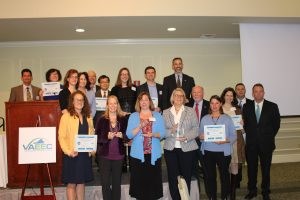 Richmond, Virginia (November 29, 2016) – The Virginia Energy Efficiency Council (VAEEC) honored the winners of its first-ever Virginia Energy Efficiency Awards at a reception in Richmond tonight attended by Governor Terry McAuliffe. VAEEC received more than 50 nominations for the 6 awards which showcase how energy efficiency champions across the Commonwealth are helping businesses, schools, government and homeowners save money on energy expenditures while reducing energy consumption — all while stimulating job growth and our economy.
Richmond, Virginia (November 29, 2016) – The Virginia Energy Efficiency Council (VAEEC) honored the winners of its first-ever Virginia Energy Efficiency Awards at a reception in Richmond tonight attended by Governor Terry McAuliffe. VAEEC received more than 50 nominations for the 6 awards which showcase how energy efficiency champions across the Commonwealth are helping businesses, schools, government and homeowners save money on energy expenditures while reducing energy consumption — all while stimulating job growth and our economy.
“Congratulations to all of the Virginia Energy Efficiency Leadership Awards winners, and thank you for your contributions to the new Virginia economy,” said Governor Terry McAuliffe, who presented all 18 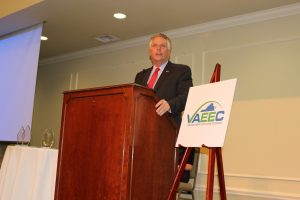 winners with their awards. “Tonight we recognize your achievements and celebrate the tremendous progress that we are making together on energy efficiency in the Commonwealth. Thank you to the Governor’s Executive Committee on Energy Efficiency for creating this vision and to the Virginia Energy Efficiency Council for pursuing that vision and supporting an industry that is vital to helping build a new Virginia economy.”
winners with their awards. “Tonight we recognize your achievements and celebrate the tremendous progress that we are making together on energy efficiency in the Commonwealth. Thank you to the Governor’s Executive Committee on Energy Efficiency for creating this vision and to the Virginia Energy Efficiency Council for pursuing that vision and supporting an industry that is vital to helping build a new Virginia economy.”
“The winning entries are proof that energy efficiency has tremendous potential to drive economic growth, create jobs, shrink utility bills, conserve natural resources and reduce pollution. They reflect the preliminary numbers from our 2016 Clean Energy Census which indicate that building energy efficiency alone accounts for $1.1B in annual revenue,” said Chelsea Harnish, VAEEC Executive Director.“We are pleased to use these awards to shine a spotlight on innovative approaches, positive impacts in our communities, unique partnerships and replicable and scalable programs. Congratulations to the winners and thanks to all 50+ applicants.”
Any person, entity or group who works on energy efficiency in Virginia was eligible for the Awards which were chosen by a Selection Committee, comprised of members of the VAEEC Education and Outreach Committee and additional volunteer members of VAEEC.
Winners: 2016 Virginia Energy Efficiency Leadership Awards
Academic
1st Place: Manassas Park Elementary School & Pre-Kindergarten
Submitted by 2rw Consultants, Inc.
2nd Place (tie): Get2Green
Submitted by Fairfax Public Schools
Henry County Public Schools
Submitted by Henry County Public Schools
Commercial
1st Place: Development of PACE Financing in Virginia
Submitted by Abacus Property Solutions, Virginia Community Capital, and McGuireWoods Consulting
2nd Place: Ballston Garage LED Retrofit
Submitted by Arlington County
3rd Place: Exact Energy Inc.
Submitted by Exact Energy, Inc.
Local Government
1st Place: Henrico County
Submitted by Henrico County
2nd Place: City of Virginia Beach
Submitted by City of Virginia Beach
3rd Place: Fontaine Fire Station
Submitted by 2rw Consultants, Inc.
Low-Income
1st Place: Live Stream Distance Learning Energy Efficiency Project
Submitted by Community Housing Project
2nd Place: Appalachian Power Company (APCO)
Submitted by Association of Energy Conservation Professionals
3rd Place: Arlington-Alexandria Energy Masters
Submitted by Arlington Alexandria Office of the Virginia Cooperative Extension, Arlingtonians for a Clean Environment, and Arlington Thrive
Residential
1st Place: WarmWise Web-Based Home Audit Program
Submitted by Columbia Gas of Virginia and Richmond ARC
2nd Place: 1922 Blair Street
Submitted by Bain-Waring Home Energy Remodeling, RIC Design Build, and Richmond Region Energy Alliance
3rd Place: Alexandria Renew Enterprises
Submitted by AlexRenew
State Government
1st Place: Virginia Department of Corrections
Submitted by the Virginia Department of Corrections
2nd Place: Department of Mines, Minerals and Energy Division of Energy
Submitted by the Department of Mines, Minerals and Energy Division of Energy
3rd Place: Department of Mines, Minerals and Energy
Submitted by the Department of Mines, Minerals and Energy
Academic
Manassas Park Elementary School & Pre-Kindergarten
Submitted by 2rw Consultants, Inc.
 The new Manassas Park Elementary School and Pre-Kindergarten were built with the goal to create a campus that was not only environmentally sustainable but that was also a resource to teach students about environmental stewardship. The buildings are designed to meet the American Institute of Architects (AIA) 2030 Challenge and use 50% less energy than code-compliant schools. Features include photo-sensors, which activate artificial light only when needed to supplement natural lighting; ground-source heat pumps, variable-speed pumping, pre-treatment and total energy recovery for ventilation air; natural ventilation; rainwater harvesting; low-consumption fixtures and kitchen equipment.
The new Manassas Park Elementary School and Pre-Kindergarten were built with the goal to create a campus that was not only environmentally sustainable but that was also a resource to teach students about environmental stewardship. The buildings are designed to meet the American Institute of Architects (AIA) 2030 Challenge and use 50% less energy than code-compliant schools. Features include photo-sensors, which activate artificial light only when needed to supplement natural lighting; ground-source heat pumps, variable-speed pumping, pre-treatment and total energy recovery for ventilation air; natural ventilation; rainwater harvesting; low-consumption fixtures and kitchen equipment.
Commercial
Development of PACE Financing in Virginia: 1st Place
Submitted by Abacus Property Solutions, Virginia Community Capital, and McGuireWoods Consulting
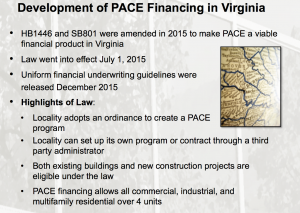 The team was largely responsible for fixing the flawed Property Assessed Clean Energy (PACE) legislation in 2015, which previously did not give the PACE lien priority over existing mortgage holders. Through their efforts, the PACE legislation passed easily – where previous years’ efforts to modify the statute failed – with very little opposition in the General Assembly. Since the legislation went into effect in July 2015, the team has been active in building interest, support and knowledge of the value proposition of PACE throughout the state.
The team was largely responsible for fixing the flawed Property Assessed Clean Energy (PACE) legislation in 2015, which previously did not give the PACE lien priority over existing mortgage holders. Through their efforts, the PACE legislation passed easily – where previous years’ efforts to modify the statute failed – with very little opposition in the General Assembly. Since the legislation went into effect in July 2015, the team has been active in building interest, support and knowledge of the value proposition of PACE throughout the state.
Local Government
Henrico County: 1st Place
Submitted by Henrico County
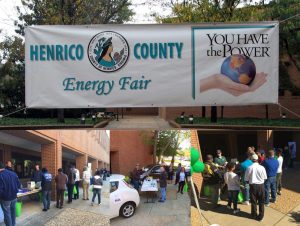 The mission of Henrico County’s Energy Management program and energy manager is to develop Henrico County Government and Schools as the leading local authorities for sustainable energy use and to promote the importance of good energy management for the economic and environmental well-being of the county’s residents and employees. The Energy Management program also strives to improve energy education and foster a culture of efficiency and sustainability in the County, while the Energy Manager supports green design and construction efforts for capital projects. Completed projects include energy audits, HVAC and lighting system upgrades, participation in demand response programs, commissioning and retro-commissioning, traffic and street light upgrades, building automation systems, and construction of a 4-megawatt methane gas to electricity generator at the landfill.
The mission of Henrico County’s Energy Management program and energy manager is to develop Henrico County Government and Schools as the leading local authorities for sustainable energy use and to promote the importance of good energy management for the economic and environmental well-being of the county’s residents and employees. The Energy Management program also strives to improve energy education and foster a culture of efficiency and sustainability in the County, while the Energy Manager supports green design and construction efforts for capital projects. Completed projects include energy audits, HVAC and lighting system upgrades, participation in demand response programs, commissioning and retro-commissioning, traffic and street light upgrades, building automation systems, and construction of a 4-megawatt methane gas to electricity generator at the landfill.
Low-Income
Live Stream Distance Learning Energy Efficiency Project: 1st Place
Submitted by Community Housing Project
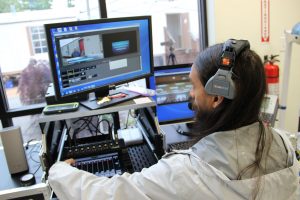 Community Housing Partners’ (CHP) innovative energy efficiency training project involved a live broadcast from a manufactured home in Virginia to the statewide Weatherization Assistance Program (WAP) conference in Minnesota. Having been a WAP provider for 40 years, CHP knows firsthand the importance of equipping WAP crew members with the knowledge, skills, and abilities to produce quality work resulting in maximum energy savings for the low-income households served by the program. CHP developed a 3.5 hour live-stream training session with relevant predefined topics and real-time Q&A, which enabled CHP to develop a new approach to energy efficiency training that will be replicated nationally, and potentially internationally.
Community Housing Partners’ (CHP) innovative energy efficiency training project involved a live broadcast from a manufactured home in Virginia to the statewide Weatherization Assistance Program (WAP) conference in Minnesota. Having been a WAP provider for 40 years, CHP knows firsthand the importance of equipping WAP crew members with the knowledge, skills, and abilities to produce quality work resulting in maximum energy savings for the low-income households served by the program. CHP developed a 3.5 hour live-stream training session with relevant predefined topics and real-time Q&A, which enabled CHP to develop a new approach to energy efficiency training that will be replicated nationally, and potentially internationally.
Residential
WarmWise Web-Based Home Audit Program: 1st Place
Submitted by Columbia Gas of Virginia and Richmond ARC
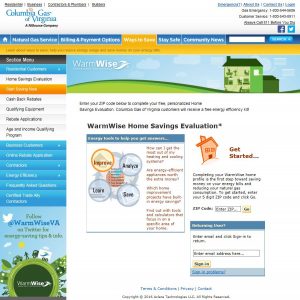 Columbia Gas of Virginia’s Web-Based Home Audit Program allows residential customers to participate in their own energy analysis and places them in the “driver’s seat” of achieving an energy efficient future. Customers participating in an online home energy audit receive a customized report recommending home improvements that can be implemented to reduce natural gas usage. Through the end of 2015, CGV’s customers have achieved over $4M in savings through the program.
Columbia Gas of Virginia’s Web-Based Home Audit Program allows residential customers to participate in their own energy analysis and places them in the “driver’s seat” of achieving an energy efficient future. Customers participating in an online home energy audit receive a customized report recommending home improvements that can be implemented to reduce natural gas usage. Through the end of 2015, CGV’s customers have achieved over $4M in savings through the program.
State Government
Virginia Department of Corrections: 1st Place
Submitted by the Virginia Department of Corrections
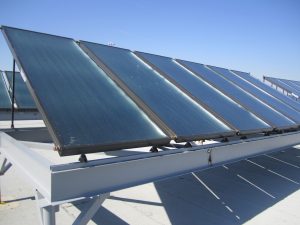 The Virginia Department of Corrections (VADOC) executed the first executive branch energy services contract (ESCO) in Virginia, leads Virginia in ESCO volume, and has embraced ESCOs as an integral part of its building renewal program. VADOC has also tied energy efficiency to its public safety mission by creating an inmate training program in energy sector skills. Additionally, VADOC employs a broad fuel portfolio including renewable and alternative energy sources
The Virginia Department of Corrections (VADOC) executed the first executive branch energy services contract (ESCO) in Virginia, leads Virginia in ESCO volume, and has embraced ESCOs as an integral part of its building renewal program. VADOC has also tied energy efficiency to its public safety mission by creating an inmate training program in energy sector skills. Additionally, VADOC employs a broad fuel portfolio including renewable and alternative energy sources
About the VAEEC
The Virginia Energy Efficiency Council is the voice for the energy efficiency industry in the Commonwealth. Our members include Fortune 500 companies, universities, nonprofits, local governments, state agencies, and utilities. The Council’s goal is to ensure that energy efficiency is an integral part to Virginia’s economy and clean energy future. Together, we are creating, implementing, and sharing energy efficiency solutions that keep costs down for residents and businesses, while improving the quality of life in our work and home environments. www.vaeec.org
Virginia’s power mix is making the clean energy shift, and it has significant opportunities for progress in improving its energy efficiency. This analysis comes from a new report from the Business Council for Sustainable Energy (BCSE), a coalition of clean energy companies that promotes the adoption of market-ready clean and sustainable energy products and services and a VAEEC partner, together with Bloomberg New Energy Finance.
Compared to the rest of the country, the Commonwealth’s carbon emissions are lower than the national average and it has lower than average power prices.
The Virginia Clean Energy Factsheet shows that Virginia is making positive steps towards a diversified energy portfolio. Overall, the Factsheet finds that last year Virginia ranked 10th in total electricity consumption, and 17th in electricity generation. This makes Virginia one of the nation’s biggest electricity importers. Natural gas provided a record 39% of electricity in 2015, while renewables grew to 5.3%. The remaining generation comes from nuclear (33%) and coal (21%).
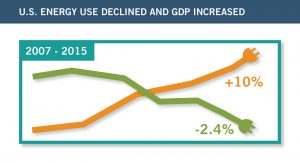
The Factsheet contains more data and analysis on the energy efficiency, renewable energy, and natural gas sectors in Virginia – providing a succinct look at Virginia’s power sector as it diversifies and moves to a lower carbon energy mix.
It also highlights that there are significant opportunities for energy savings to be realized through energy efficiency measures and programs. The right energy efficiency programs can reduce energy costs for consumers, benefit the economy, and reduce emissions. They can also help make Virginia more energy independent.
Nationwide, energy efficiency programs and services implemented over the past several decades have contributed significantly to the increased energy productivity of the U.S. economy. According to BCSE’s 2016 Sustainable Energy in America Factbook, energy efficiency has led to the decoupling of GDP and energy consumption; between 2007 and 2015, GDP went up 10%, while energy consumption actually went down by 2.4%. This means that every unit of GDP requires less and less energy spending to produce.
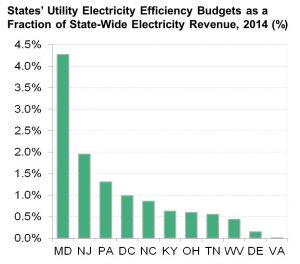
National spending on these energy efficiency programs grew 25% per year from 2006 to 2011, reflecting the growing acknowledgement of its economic and energy benefits.
Despite this surge in national spending on energy efficiency, Virginia has not been as quick to make similar investments. Virginia ranks 31st according to ACEEE’s energy efficiency scoring system, and ranks last among states in utility spending on energy efficiency as a percentage of revenue. In 2014, Virginia spent just .01% of electricity revenues on energy efficiency programs, while Maryland and New Jersey (states that also operate in the PJM market) spend 4.3% and 2.0%, respectively.
Investments in energy efficiency products and services have demonstrable benefits to consumers. From 2010 to 2015, as national spending increased, consumers actually saw reductions in their electricity use and bills. The Factbook shows that the average U.S. residential customer used 6.2% less electricity, despite owning more gadgets, and paid about $80 less in real dollars on their electricity bills annually.
In Virginia, the Factsheet shows the energy savings potential is a cumulative 23% by 2030. That means avoiding 25TWh of generation in 2030.
Given these benefits, as the Governor’s Executive Order 57 Working Group on emissions reduction continues to seek ways to reduce the Commonwealth’s carbon footprint, energy efficiency should be prioritized. It is a cost effective way to cut back on emissions that also saves money for consumers.
Other policy makers are well positioned to take action on energy efficiency. The General Assembly took an important step towards advancing energy efficiency in the Commonwealth by mandating that the State Corporation Commission evaluate the establishment of uniform protocols for measuring verifying, validating, and reporting on the impacts of utility energy efficiency programs. Establishing a robust system for evaluation, measurement, and verification (EM&V) will be crucial to the success of energy efficiency programs. BCSE has recommended that the SCC consider the many well established resources available on EM&V as it makes decisions about how Virginia will move forward with EM&V protocols.
The Commonwealth is in a good position to deepen its commitment to an economic growth pathway that further embraces a diverse portfolio of clean energy resources. Energy efficiency is a key component of that portfolio, and one through which Virginia stands to gain significant economic and energy saving benefits.
 This guest blog post was written for VAEEC by Carolyn Sloan, Manager, Federal Policy, with the Business Council for Sustainable Energy.
This guest blog post was written for VAEEC by Carolyn Sloan, Manager, Federal Policy, with the Business Council for Sustainable Energy.
For more information on the Business Council for Sustainable Energy and to download a free copy of the Virginia Factsheet and Sustainable Energy Factbook please visit bcse.org/sustainableenergyfactbook.
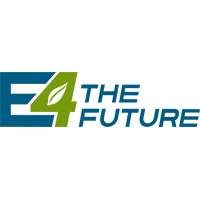 Variability among state/regional structures and rules is a barrier to achieving a well-functioning energy market that provides clean and cost-effective electricity. That’s the conclusion of a paper published by VAEEC Business Platinum member E4TheFuture, November’s Featured Member of the Month. E4TheFuture intends that the paper will help inform organizations who wish to improve governance structures and market rules.
Variability among state/regional structures and rules is a barrier to achieving a well-functioning energy market that provides clean and cost-effective electricity. That’s the conclusion of a paper published by VAEEC Business Platinum member E4TheFuture, November’s Featured Member of the Month. E4TheFuture intends that the paper will help inform organizations who wish to improve governance structures and market rules.
Which areas of the U.S. enable the voices of clean energy and advanced energy technology advocates as decision-makers in the market structures — such as PJM Interconnection* — that govern their playing field? To what extent are these voices provided a vote, compared with traditional power generators, transmission and distribution companies, utility regulators, and “legacy” leadership? How is the Federal Energy Regulatory Agency (FERC) involved? Can missed opportunities of the past be transformed from challenges into opportunities? These questions are raised in E4TheFuture’s paper, authored by Synapse Energy Economics consultants with an introduction and conclusions by E4TheFuture. The paper, Regional Energy Markets: Do Inconsistent Governance Structures Impede U.S. Market Success?, is available as a free download.
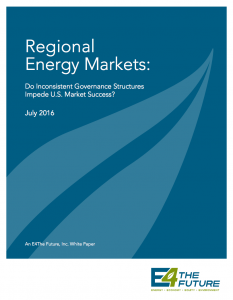 VAEEC member E4TheFuture is a nonprofit that promotes residential clean energy and sustainable resource solutions to advance climate protection and economic fairness. The organization does this by influencing federal, state and local policies, and by helping to build a resilient and vibrant energy efficiency and clean energy sector. “E4” stands for energy, economy, equity, and environment: promoting clean, efficient Energy; growing a low-carbon Economy; ensuring low-income residents can access clean, efficient, affordable energy (Equity); restoring a healthy Environment for people, prosperity and the planet. E4TheFuture was known as Conservation Services Group (CSG), until the sale of its operating programs and brand in 2015 to CLEAResult.
VAEEC member E4TheFuture is a nonprofit that promotes residential clean energy and sustainable resource solutions to advance climate protection and economic fairness. The organization does this by influencing federal, state and local policies, and by helping to build a resilient and vibrant energy efficiency and clean energy sector. “E4” stands for energy, economy, equity, and environment: promoting clean, efficient Energy; growing a low-carbon Economy; ensuring low-income residents can access clean, efficient, affordable energy (Equity); restoring a healthy Environment for people, prosperity and the planet. E4TheFuture was known as Conservation Services Group (CSG), until the sale of its operating programs and brand in 2015 to CLEAResult.

Steve Cowell and Sarah Jackson
In August 2016 president of E4TheFuture Steve Cowell, with Sarah Jackson and Paul Peterson of Synapse Energy Economics, hosted a briefing call about the Regional Energy Markets paper. Jackson and Peterson reviewed each region’s market governance structure, noting what Synapse found and inviting questions.
Of particular interest to VAEEC, it was noted during the briefing that PJM’s current voting members representing advanced energy technology interests are a fragmented group of small companies, which results in a diluted voice on these issues. Paul Peterson pointed out that wind energy advocates are active but overall, more participation by clean energy advocates either via the Public Interest & Environmental Organizations User Group or through development of a separate voting sector such as the Alternative Resources sector in New England, may be helpful. Steve Cowell raised the possibility of creating a user group for PJM’s alternative resource sector, which might be able to evolve into such a voting sector.
“The full range of resources should be explicitly included,” says Steve. “Clean energy resources such as energy efficiency and other distributed energy resources along with demand response need to be more strongly represented in wholesale electricity markets through a more evolved ISO and RTO governance.”
A September 2016 blog by Dylan Reed and Arvin Ganesan of Advanced Energy Economy (AEE), How Grid Governance Stands in the Way of Advanced Energy Progress, recaps the paper’s highlights with additional AEE commentary on the challenges advanced energy resources face under the current variable structures of regional and state electricity market governance.
*PJM Interconnection coordinates the movement of wholesale electricity and ensures power supplies for 61 million people in 13 states & D.C. On October 21, a new Learning Center highlights features of the Markets and Operations page: a real-time snapshot of PJM’s operations and markets, current load, fuel mix, locational marginal prices and ancillary services. The new page explains the dashboard’s wind and solar power graphs.
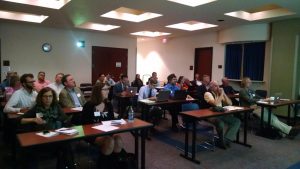 Last week (Oct. 6, 2016), the Virginia Energy Efficiency Council held a successful workshop for utility staff, evaluators, regulators, implementers and other stakeholders on EM+V 2.0 (Evaluation, Measurement + Verification).
Last week (Oct. 6, 2016), the Virginia Energy Efficiency Council held a successful workshop for utility staff, evaluators, regulators, implementers and other stakeholders on EM+V 2.0 (Evaluation, Measurement + Verification).
This past spring, while we at the VAEEC were drafting our comments and collecting those from member organizations to the State Corporation Commission on the establishment of EM+V protocols, we took the opportunity to discuss this concept of “Enhanced EM+V”, “EM+V 2.0” or “Automated EM+V”. For the purposes of this post, we will use the term “EM+V 2.0” moving forward. As we stated in our comments, “these methods can provide opportunities for utilities and regulators to gain program insights in near real-time, speed up the evaluation process and potentially reduce the associated costs.”
During a conference call with our utility members to review and provide feedback on our comments, there was general agreement that a workshop to delve deeper into this complex topic would be useful. In the VAEEC’s role as a resource provider to our members and stakeholders, it made sense for us to take this on.
Our expert presenters came from diverse backgrounds, which allowed our participants to learn about EM+V 2.0 from a variety of different perspectives. Our presenters included:
Katherine began the workshop with a quick primer on EM+V in general, including why evaluation is necessary for utility programs and the advantages and challenges of EM+V 2.0. She also discussed how EM+V 2.0 fit into the bigger picture and provided some examples of which programs it is useful to evaluate and which ones it may not be useful for. She also briefly mentioned her work as the independent evaluator in Arkansas and how that evaluation model works.
Following Katherine, was Maggie Molina with ACEEE who discussed ACEEE’s work in this field and discussed the findings from their report on the subject.
Next, was Jake Oster who works for EnergySavvy, a company whose software is used in this field. Jake discussed their product and provided several client case studies on the residential side.
Jessica Granderson with the Lawrence Berkeley National Lab presented on the EM+V 2.0 pilot programs they are doing as well as providing some examples of commercial EM+V 2.0.
Our last speaker of the day was Tim Petit who summarized some of the content already discussed by previous speakers and went into further detail about a NEEP report that came out recently.
All of their presentations can be accessed via links above and found on our resources page.
Following all of the presentations, we welcomed all of the presenters back to the front of the room for a panel discussion on what had been previously discussed, to answer questions and to start the dialogue on next steps.
We plan to follow up with participants with a survey to get feedback on how to continue the conversation.
From my perspective, simply having the number of participants we had and knowing they were engaged on the issue made this workshop a success. We appreciated the thoughtful questions and the discussion that ensued.
A lot has happened on the building codes front since we put out a call for nominees for the board of the Virginia Department of Housing and Community Development (DHCD). As you may recall, this board is charged with updating Virginia’s building codes.
 The board is comprised of 14 members: 11 appointed members who represent Virginia’s congressional districts and three ex-officio members who represent the Virginia Housing Development Authority (VHDA); the Virginia Building Code Officials Association (VBCOA); and the Virginia Fire Services Board (VFSB).
The board is comprised of 14 members: 11 appointed members who represent Virginia’s congressional districts and three ex-officio members who represent the Virginia Housing Development Authority (VHDA); the Virginia Building Code Officials Association (VBCOA); and the Virginia Fire Services Board (VFSB).
Over the last several years, the makeup of this board has changed in a positive way. As a demonstration of his commitment to energy efficiency, Governor McAuliffe has appointed several members to this board, including one specifically recruited by the VAEEC, who acknowledge the science and economics that support rigorous energy codes.
However, even with the new board diversity, there is much work to be done. In 2014, Virginia adopted the 2012 “model” building codes published by the ICC with amendments. In the case of the residential codes section, Virginia’s amendments created a code that looks more like the 2009 IECC rather than the 2012 IECC. Per Virginia policy, amendments made in previous years stand until they are expressly removed or altered by the board.
Given that there are few substantive changes between the 2012 and 2015 IECC standards, if Virginia does not adopt these new standards, we will remain woefully behind our neighbors who have already adopted the 2012 and/or 2015 IECC standards for new homes.
Check out this great fact sheet on Virginia and the 2012 IECC codes.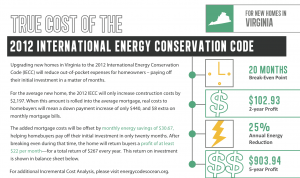
In the most recent State Energy Efficiency Scorecard, the American Council for an Energy Efficient Economy (ACEEE) ranked Virginia 28th in the country on building code regulations, and there is still considerable work to be done.
Currently, the only change to the 2012 residential amendments that has received support from the board is changing the requirement for high efficiency lamps in new homes from 50% to 75% (an improvement the DHCD board declined during the last cycle). VAEEC Governance Board member Andrew Grigsby of the Local Energy Alliance Program (LEAP), has two proposals before the board to require mechanical testing to measure residential building air-tightness and duct leakage (doing away with the visual inspection options). These proposals will be taken up at the next meeting on October 24th along with:
- Commercial energy codes: Maintaining current projection factors and Solar Heat Gain Coefficient (SHGC) formulas and declining weaker 2015 IECC specs for this element.
- Eliminating the credit for on-site generation in the Energy Rating Index compliance option.
- Increasing the requirement for exterior wall insulation from R15 (or R13 cavity + R1 insulated sheathing) to R20 (or 13+5).
Proposals that were voted out unfavorably at the September Codes and Standards Committee:
- Adopting the 2015 IECC without alteration
- updating the attic insulation requirement from R-38 to R-49 (per the 2012 IECC)
- Requiring that replacement windows meet minimum efficiency requirements when a permit is required (per the 2012 IECC)
- Removing an amendment allowing efficiency trade-offs in buildings with less fenestration (per the 2012 IECC)
 The Governor’s Executive Committee on Energy Efficiency has been presented data showing advanced building energy codes should be a vital component for Virginia to meet its goal to reduce energy consumption ten percent by 2020.
The Governor’s Executive Committee on Energy Efficiency has been presented data showing advanced building energy codes should be a vital component for Virginia to meet its goal to reduce energy consumption ten percent by 2020.
Everyone wins when new homes are built to the most cost-effective efficiency standards: consumers, builders, trades, grid operators, and society as a whole. This is why VAEEC continues to support rigorous energy codes.
Upcoming Important Dates:
10/24/16: DHCD board committee meets to approve or reject remaining proposals
11/21/16: DHCD Board meets to adopt draft proposal of new code regulations
Winter 2017: Draft regulations published in the Virginia Register for public comment
February-June 2017: Public comment period on draft regulations
6/19/17: Public Hearing on draft regulations
September and October 2017: DHCD board committees meet to vote on final regulations
November 2017: DHCD board adopts final code regulations
The full DHCD board timeline found here. Or check the DHCD website for details.

 On January 10, 2017, VAEEC and LEAP
On January 10, 2017, VAEEC and LEAP  to reinforce the power and benefits that energy efficiency can bring to Virginia,” said Steiner. “The VAEEC membership is a wide array of all that makes our Commonwealth function – from business to government, academia to laborers, and residential, commercial and industrial players. We will seek every opportunity to advance Virginia’s most cost-effective energy solution: energy efficiency. The VAEEC invites business, political and community leaders – of all stripes – to join us in leading Virginia forward.”
to reinforce the power and benefits that energy efficiency can bring to Virginia,” said Steiner. “The VAEEC membership is a wide array of all that makes our Commonwealth function – from business to government, academia to laborers, and residential, commercial and industrial players. We will seek every opportunity to advance Virginia’s most cost-effective energy solution: energy efficiency. The VAEEC invites business, political and community leaders – of all stripes – to join us in leading Virginia forward.”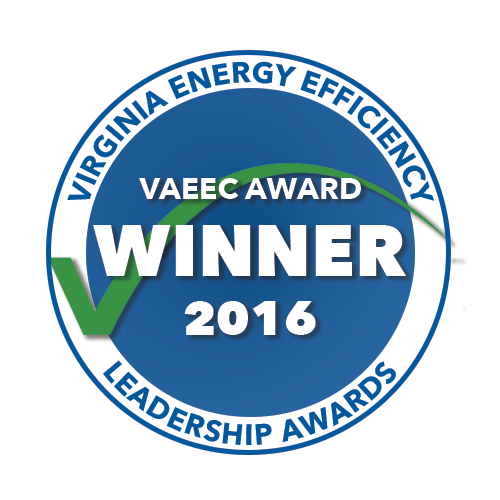
 Richmond, Virginia (November 29, 2016)
Richmond, Virginia (November 29, 2016) winners with their awards.
winners with their awards. The new Manassas Park Elementary School and Pre-Kindergarten were built with the goal to create a campus that was not only environmentally sustainable but that was also a resource to teach students about environmental stewardship. The buildings are designed to meet the American Institute of Architects (AIA) 2030 Challenge and use 50% less energy than code-compliant schools. Features include photo-sensors, which activate artificial light only when needed to supplement natural lighting; ground-source heat pumps, variable-speed pumping, pre-treatment and total energy recovery for ventilation air; natural ventilation; rainwater harvesting; low-consumption fixtures and kitchen equipment.
The new Manassas Park Elementary School and Pre-Kindergarten were built with the goal to create a campus that was not only environmentally sustainable but that was also a resource to teach students about environmental stewardship. The buildings are designed to meet the American Institute of Architects (AIA) 2030 Challenge and use 50% less energy than code-compliant schools. Features include photo-sensors, which activate artificial light only when needed to supplement natural lighting; ground-source heat pumps, variable-speed pumping, pre-treatment and total energy recovery for ventilation air; natural ventilation; rainwater harvesting; low-consumption fixtures and kitchen equipment. The team was largely responsible for fixing the flawed Property Assessed Clean Energy (PACE) legislation in 2015, which previously did not give the PACE lien priority over existing mortgage holders. Through their efforts, the PACE legislation passed easily – where previous years’ efforts to modify the statute failed – with very little opposition in the General Assembly. Since the legislation went into effect in July 2015, the team has been active in building interest, support and knowledge of the value proposition of PACE throughout the state.
The team was largely responsible for fixing the flawed Property Assessed Clean Energy (PACE) legislation in 2015, which previously did not give the PACE lien priority over existing mortgage holders. Through their efforts, the PACE legislation passed easily – where previous years’ efforts to modify the statute failed – with very little opposition in the General Assembly. Since the legislation went into effect in July 2015, the team has been active in building interest, support and knowledge of the value proposition of PACE throughout the state. The mission of Henrico County’s Energy Management program and energy manager is to develop Henrico County Government and Schools as the leading local authorities for sustainable energy use and to promote the importance of good energy management for the economic and environmental well-being of the county’s residents and employees. The Energy Management program also strives to improve energy education and foster a culture of efficiency and sustainability in the County, while the Energy Manager supports green design and construction efforts for capital projects. Completed projects include energy audits, HVAC and lighting system upgrades, participation in demand response programs, commissioning and retro-commissioning, traffic and street light upgrades, building automation systems, and construction of a 4-megawatt methane gas to electricity generator at the landfill.
The mission of Henrico County’s Energy Management program and energy manager is to develop Henrico County Government and Schools as the leading local authorities for sustainable energy use and to promote the importance of good energy management for the economic and environmental well-being of the county’s residents and employees. The Energy Management program also strives to improve energy education and foster a culture of efficiency and sustainability in the County, while the Energy Manager supports green design and construction efforts for capital projects. Completed projects include energy audits, HVAC and lighting system upgrades, participation in demand response programs, commissioning and retro-commissioning, traffic and street light upgrades, building automation systems, and construction of a 4-megawatt methane gas to electricity generator at the landfill. Community Housing Partners’ (CHP) innovative energy efficiency training project involved a live broadcast from a manufactured home in Virginia to the statewide Weatherization Assistance Program (WAP) conference in Minnesota. Having been a WAP provider for 40 years, CHP knows firsthand the importance of equipping WAP crew members with the knowledge, skills, and abilities to produce quality work resulting in maximum energy savings for the low-income households served by the program. CHP developed a 3.5 hour live-stream training session with relevant predefined topics and real-time Q&A, which enabled CHP to develop a new approach to energy efficiency training that will be replicated nationally, and potentially internationally.
Community Housing Partners’ (CHP) innovative energy efficiency training project involved a live broadcast from a manufactured home in Virginia to the statewide Weatherization Assistance Program (WAP) conference in Minnesota. Having been a WAP provider for 40 years, CHP knows firsthand the importance of equipping WAP crew members with the knowledge, skills, and abilities to produce quality work resulting in maximum energy savings for the low-income households served by the program. CHP developed a 3.5 hour live-stream training session with relevant predefined topics and real-time Q&A, which enabled CHP to develop a new approach to energy efficiency training that will be replicated nationally, and potentially internationally. Columbia Gas of Virginia’s Web-Based Home Audit Program allows residential customers to participate in their own energy analysis and places them in the “driver’s seat” of achieving an energy efficient future. Customers participating in an online home energy audit receive a customized report recommending home improvements that can be implemented to reduce natural gas usage. Through the end of 2015, CGV’s customers have achieved over $4M in savings through the program.
Columbia Gas of Virginia’s Web-Based Home Audit Program allows residential customers to participate in their own energy analysis and places them in the “driver’s seat” of achieving an energy efficient future. Customers participating in an online home energy audit receive a customized report recommending home improvements that can be implemented to reduce natural gas usage. Through the end of 2015, CGV’s customers have achieved over $4M in savings through the program. The Virginia Department of Corrections (VADOC) executed the first executive branch energy services contract (ESCO) in Virginia, leads Virginia in ESCO volume, and has embraced ESCOs as an integral part of its building renewal program. VADOC has also tied energy efficiency to its public safety mission by creating an inmate training program in energy sector skills. Additionally, VADOC employs a broad fuel portfolio including renewable and alternative energy sources
The Virginia Department of Corrections (VADOC) executed the first executive branch energy services contract (ESCO) in Virginia, leads Virginia in ESCO volume, and has embraced ESCOs as an integral part of its building renewal program. VADOC has also tied energy efficiency to its public safety mission by creating an inmate training program in energy sector skills. Additionally, VADOC employs a broad fuel portfolio including renewable and alternative energy sources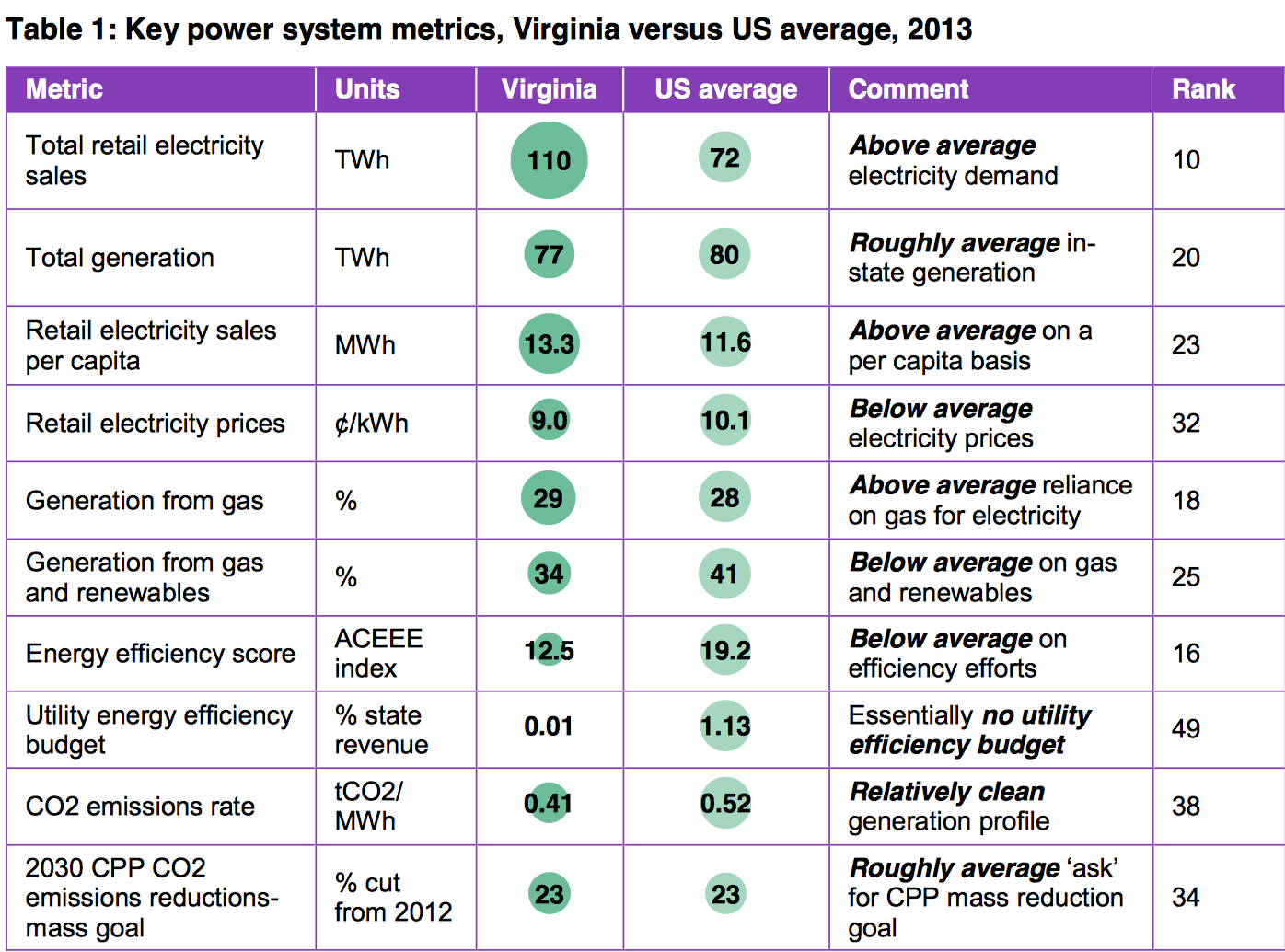


 This guest blog post was written for VAEEC by Carolyn Sloan, Manager, Federal Policy, with the
This guest blog post was written for VAEEC by Carolyn Sloan, Manager, Federal Policy, with the 


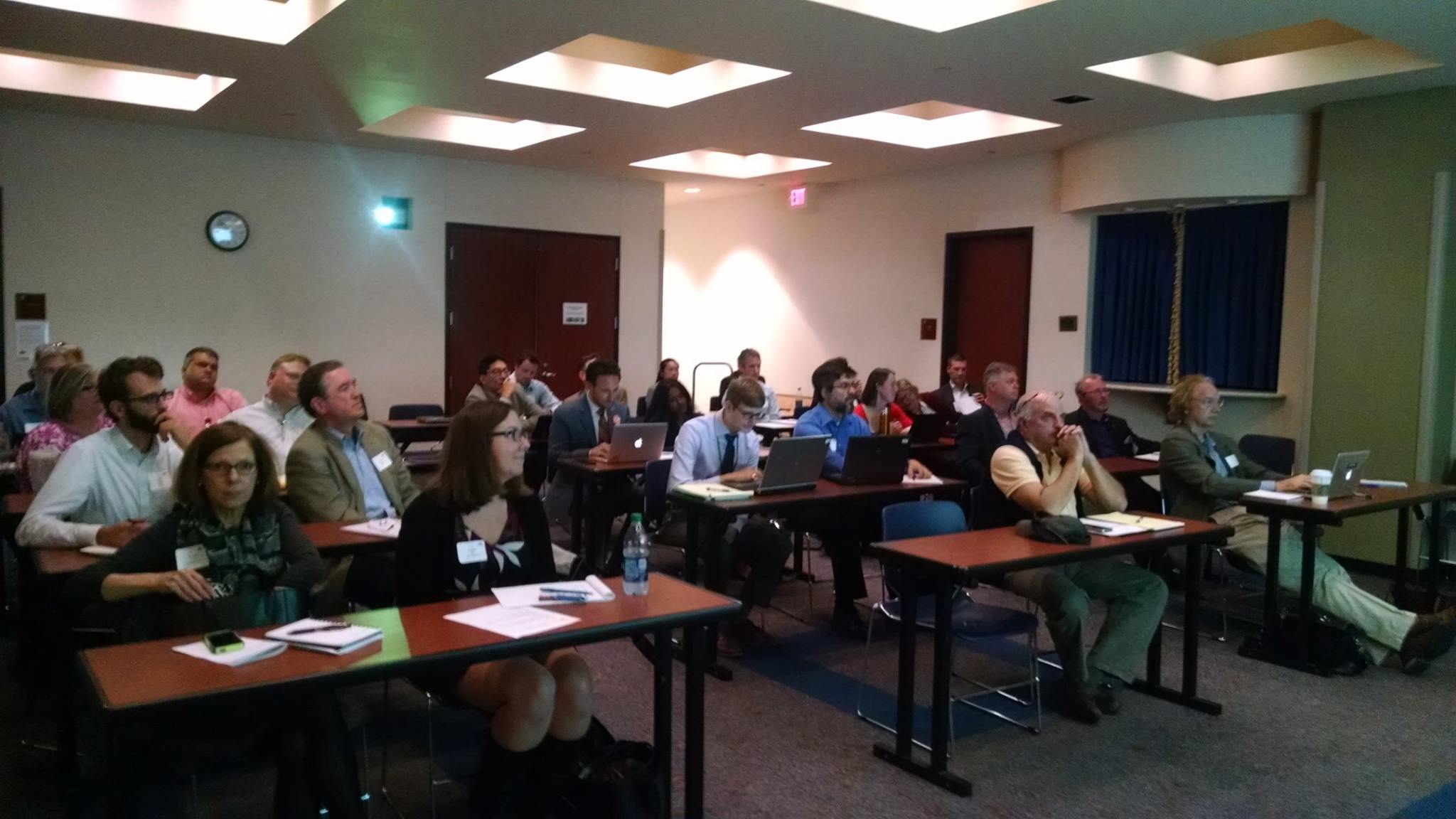
 Last week (Oct. 6, 2016), the Virginia Energy Efficiency Council held a successful workshop for utility staff, evaluators, regulators, implementers and other stakeholders on EM+V 2.0 (Evaluation, Measurement + Verification).
Last week (Oct. 6, 2016), the Virginia Energy Efficiency Council held a successful workshop for utility staff, evaluators, regulators, implementers and other stakeholders on EM+V 2.0 (Evaluation, Measurement + Verification).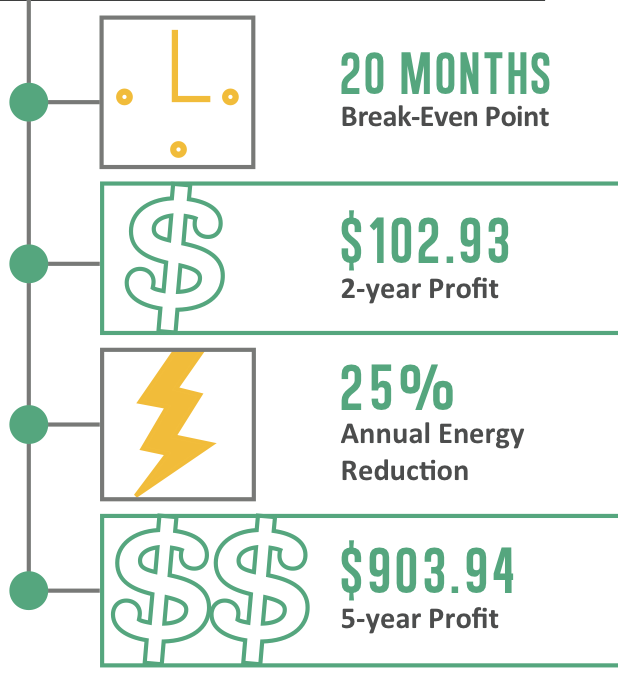
 The board is comprised of 14 members: 11 appointed members who represent Virginia’s congressional districts and three ex-officio members who represent the Virginia Housing Development Authority (VHDA); the Virginia Building Code Officials Association (VBCOA); and the Virginia Fire Services Board (VFSB).
The board is comprised of 14 members: 11 appointed members who represent Virginia’s congressional districts and three ex-officio members who represent the Virginia Housing Development Authority (VHDA); the Virginia Building Code Officials Association (VBCOA); and the Virginia Fire Services Board (VFSB).
 The Governor’s Executive Committee on Energy Efficiency has been presented data showing advanced building energy codes should be a vital component for Virginia to meet its goal to reduce energy consumption ten percent by 2020.
The Governor’s Executive Committee on Energy Efficiency has been presented data showing advanced building energy codes should be a vital component for Virginia to meet its goal to reduce energy consumption ten percent by 2020.